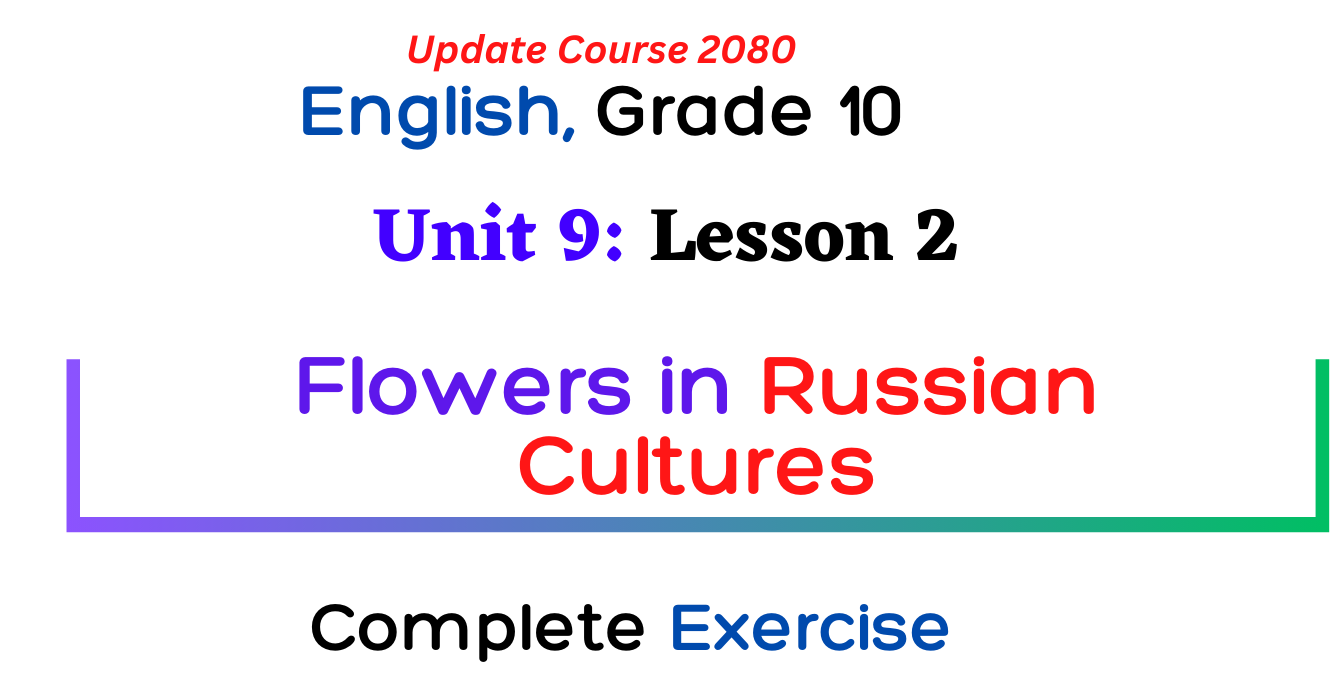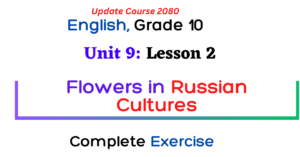Climbing
Class 10 English Guide 2080 Unit 9 History & Culture, Lesson 2 Flowers in Russian Cultures Exercise, Question Answer, Summary Grammar Writing Solution note.
Check: SEE Class 10 Model Question 2080/2081
Reading I
A. Find out the single words for the following meanings.
Answer
:
a. a strong, usually pleasant smell:
aroma
b. different colours of paint, especially as used by an artist:
palette
c. to a great degree:
immensely
d. lasting only a short time:
fleeting
e. the act or process of producing children or baby animals:
procreation
f. enclose (something) in or as if in a capsule:
encapsulate
g. a type of treatment which involves massaging the body with special fragrant oils:
aromatherapy
h. causing to be kept away:
repellent
i. to be a sign of something that will happen in the future:
foreshadow
B. Words like gift-giving, heartwarming, cardboard, etc., are compound words. Make a list of such compound words from the text.
Answer
:
Lesser-known
Fortune-telling
Self-murmured
Newly-wed
Cardboard
Aromatherapy
Flower-gifting
Heartwarming
C. Complete the sentences below with the correct information from the text.
Answer
:
a. People do not care which flowers they are receiving as long as the flowers are beautiful and give off a
pleasant aroma.
b. Flowers are gifted worldwide to express
love and affection.
c. Following the strict flower
etiquette
while gifting flowers in Russia saves you from offending people.
d. Red carnations symbolize the 1917
February Revolution
produced by the Russian Social Democratic Workers’ Party of Bolsheviks.
e. Russian people believe that the white carnation
symbolizes bad omens
, so we should not gift them to performers.
f. Russian people do not gift red puppy flowers to their
beloved ones
because they think it weakens their loved one.
g. When Russians want to break up with their beloved ones, they gift
a bunch of yellow flowers
.
h. Chamomiles have
medicinal
values, so they can be used for the treatment of fatal diseases.
i. We should not gift a white lily bouquet in a Russian wedding as it symbolizes
death.
D. Answer these questions.
Answer
:
a. Mention any two reasons for which people gift flowers to others.
Ans: People give flowers to others for various reasons, such as expressing love, appreciation, sympathy, gratitude, congratulations, or to simply brighten someone’s day.
b. How do people feel when they are gifted flowers?
Ans:Receiving flowers as a gift generally makes people feel happy and appreciated. Flowers have been shown to have a positive impact on mood, reducing stress and anxiety.
c. What determines the selection of flowers for gifting in Russia?
Ans: The selection of flowers for gifting in Russia is often influenced by their symbolic meanings. For example, red roses are commonly given as a symbol of love, while yellow flowers may be associated with jealousy or betrayal
d. Which event in Russian history is reflected by the red carnation?
Ans: The red carnation is associated with the October Revolution of 1917 in Russia, which marked the beginning of the Soviet era
e. Does a Russian like to keep a white carnation under his/her pillow? Why?
Ans: Do Russians place a white carnation under their pillow? If so, why? Yes, it is believed in Russia that placing a white carnation under one’s pillow can bring about good dreams and promote peaceful sleep.
f. What’s the reason for connecting the red puppy with fragile love?
Ans:The red poppy is often associated with fragile love due to its delicate petals and short lifespan, symbolizing the fleeting nature of romantic relationships.
g. What makes the Russian people eat red puppy seeds in their wedding?
Ans: In Russian culture, it is believed that consuming red poppy seeds during a wedding brings good luck and fertility to the newlyweds.
h. Do you prefer to grow chamomile in your garden? Why?
Ans: Chamomile is a favored choice among many gardeners due to its ease of cultivation and numerous health benefits.
I. What colour is chamomile?
Ans: Chamomile flowers are typically white with a yellow center.
j. Write the names of two flowers used for fortune telling.
Ans:
Two flowers commonly used for fortune-telling are dandelions and marigolds.
k. Which flower is mostly used in Russian weddings?
Ans: The most commonly used flower in Russian weddings is the white lily
.
E. Do you know other flowers that are commonly used for gifting? Write the names of those flowers and the occasions on which they are gifted.
Answer
:
Roses – Roses are versatile flowers and are often given on occasions like Valentine’s Day, anniversaries, birthdays, and to express love and affection.
Lilies – Lilies are elegant flowers that symbolize purity and beauty. They are often gifted for weddings, anniversaries, and to offer condolences during funerals.
Tulips – Tulips are vibrant and cheerful flowers. They are popular gifts for birthdays, Mother’s Day, and to convey a message of appreciation and admiration.
Sunflowers – Sunflowers are known for their bright and sunny appearance. They make great gifts for birthdays, housewarmings, and to uplift someone’s mood.
Orchids – Orchids are exotic and elegant flowers that represent luxury and beauty. They are commonly gifted for birthdays, graduations, and to express admiration.
Carnations – Carnations are versatile flowers available in various colors. They are often given on Mother’s Day, as they symbolize maternal love. They are also suitable for birthdays and anniversaries.
Daisies – Daisies are cheerful and symbolize innocence and purity. They are popular for birthdays, get-well-soon wishes, and to express friendship.
Gerberas – Gerbera daisies are vibrant and colorful flowers that represent happiness and joy. They are commonly gifted for birthdays, housewarming parties, and to uplift spirits.
Chrysanthemums – Chrysanthemums come in different colors and are associated with autumn. They are often given for birthdays, as well as to celebrate Mother’s Day in some cultures.
Irises – Irises are elegant flowers that symbolize wisdom and faith. They are suitable for birthdays, as well as to express condolences or support during challenging times.
Grammar II
A. Complete the following sentences with the correct form of the verb in the brackets.
Answer
:
a. The children .. . five minutes ago. (arrive)
Ans:
arrived
b. Ramchandra…….. the ticket before he went to the cinema. (buy)
Ans:
had bought
c. Alexander……. one-fourth of the world before he was thirty. (conquer)
Ans:
conquered
d. When she came out of the airport, nobody . . . . for her. (wait)
Ans:
was waiting
f. I found a thousand rupee note in my pants pocket while I……it. (wash)
Ans:
was washing
g. Somebody ….at my door while I was taking a rest. (knock)
Ans:
knocked
h. Every year, he ………some money which he spent to buy a new house. (save)
Ans:
saved
i.I ……….. my breakfast before I went to work. (have)
Ans:
was having
j. The train…….. before we reached the station. (leave)
Ans:
had left
B.Complete the story below with the correct form of the verbs given in the brackets.
Answer
:
A young lady
entered
a shop in Birendranagar, Surkhet. She
put
a few items of food in a bag. She
chose
a time when not many people
were
there in the street. She
waited
for the moment when no one else would see her running away. When the shopkeeper
checked
the goods, she gave him a thousand-rupee note. As soon as the shopkeeper
opened
the box, she
snatched
all the money from it. Meanwhile, she
had run
out of the shop before the shopkeeper
realized
what
had
happened. When the shopkeeper
checked
the amount in the box, he
found
that the thief
had taken
only Rs. 450. As the thief
had left
a thousand-rupee note behind, the operation
cost
her Rs. 550.
Writing II
A. Write a story using the outlines given below.
The Bat, the Birds, and the Beasts
a great conflict between the birds and the beasts ……. two armies collected together …… the bat refuses to join ……. says he is a beast ………. beasts request …… says he is a bird ….. peace made, no battle ….. rejoicing …….. bat wishes to join ……….. both turn against him ….. threaten to tear into pieces …… bat flies away …………moral
Answer
:
Once upon a time, in a distant land, there arose a great conflict between the birds and the beasts. The disagreement escalated to such an extent that both sides decided to gather their armies and prepare for a full-scale war. The birds, with their majestic wings and sharp beaks, lined up on one side, while the formidable beasts, with their powerful claws and ferocious roars, assembled on the other.
As the tension grew, a small creature named Bat watched from the sidelines, unsure of where it belonged. The Bat possessed both the characteristics of a bird and a beast. It had wings like the birds, enabling it to fly gracefully through the air, but it also had the body of a small mammal, which classified it as a beast.
When representatives from both armies approached the Bat, urging it to join their ranks, the creature hesitated. “I cannot pick a side,” the Bat declared firmly. “For I am neither a bird nor a beast. I am simply a creature of the night.”
The beasts, desperate to strengthen their numbers, implored the Bat, saying, “But Bat, your wings allow you to soar above the battlefield, giving us an advantage. Join us, and together we shall conquer the skies!”
The Bat, not willing to be swayed, responded, “I am sorry, my friends, but I am a beast. I cannot forsake my nature.”
The birds, hearing the Bat’s response, decided to intervene. They approached the Bat, asking, “Bat, your ability to fly places you among us. Join our flock, and we shall protect you.”
The Bat, feeling conflicted, replied, “Dear birds, I appreciate your offer, but I am a beast. I cannot deny the truth of my being.”
Seeing the deadlock and realizing the futility of war, the birds and the beasts agreed to make peace. A truce was declared, and the two armies disbanded. There was great rejoicing, as the creatures celebrated the avoidance of bloodshed and destruction.
However, as the celebrations filled the air, the Bat’s heart swelled with a longing to be a part of the unity and joy. It decided to approach the birds and the beasts, hoping they would accept it despite its dual nature.
But to its dismay, both sides turned against the Bat. They felt betrayed by its earlier refusal to join them in their time of need. Angry and frustrated, they threatened to tear the Bat into pieces, casting it out of their newfound harmony.
Feeling rejected and hurt, the Bat swiftly spread its wings and took flight, leaving the creatures behind. As it soared into the night, the Bat realized the importance of staying true to oneself and accepting one’s own identity, regardless of the expectations of others.
The moral of the story is that one should never compromise their true nature or try to fit into predefined categories. Embracing our uniqueness and staying true to ourselves is the key to finding our place in the world, even if it means standing alone.
B. Write a story that begins with the sentence ‘One warm summer afternoon an old owl was dozing when a grasshopper disturbed it with a very raspy song.’
Answer
:
One warm summer afternoon, an old owl perched high on a branch, its feathers ruffled by a gentle breeze. The forest was alive with the soft whispers of leaves and the distant hum of insects. The owl, tired from a long night of hunting, had decided to rest and enjoy the tranquility of the day. It closed its eyes and began to doze, finding solace in the peacefulness of the forest.
But suddenly, a shrill and raspy sound pierced the silence, interrupting the owl’s peaceful slumber. The old owl opened its eyes and swiveled its head to locate the source of the disturbance. There, perched on a nearby blade of grass, was a grasshopper, rubbing its legs together to produce the cacophonous noise.
Startled by the grasshopper’s audacity, the owl glared at it with wide, yellow eyes. “What is the meaning of this intrusion?” the owl hooted, his voice stern and filled with annoyance.
The grasshopper, unaware of the owl’s irritation, continued its raspy song, completely absorbed in its own melody. Its emerald green body shimmered under the golden sunlight, its wings fluttering in rhythm with the song.
Undeterred by the owl’s disapproval, the grasshopper leaped from the blade of grass and landed on a nearby flower, using it as a stage for its performance. The vibrant petals of the flower swayed gently as if dancing to the grasshopper’s tune.
As the grasshopper sang, its raspy song echoed through the forest, reaching the ears of other woodland creatures. Curiosity piqued, a family of squirrels paused their gathering activities and scampered over to witness this unusual spectacle. They perched themselves on the surrounding branches, their fluffy tails twitching with anticipation.
Even the bees and butterflies couldn’t resist the allure of the grasshopper’s song. They fluttered around, their delicate wings creating a delicate melody of their own. The forest came alive with a symphony of nature, an impromptu concert that blended the sounds of the grasshopper, the buzzing bees, and the rustling leaves.
As the grasshopper’s raspy song continued, the old owl’s annoyance began to wane. It couldn’t help but be captivated by the grasshopper’s passionate performance and the harmony it created with the forest. The owl’s stern expression softened, and a hint of a smile played across its wise, weathered face.
And so, on that warm summer afternoon, the old owl and the grasshopper unwittingly collaborated, creating a moment of unexpected unity in the heart of the forest. The other creatures, enchanted by the harmonious symphony, couldn’t help but be moved by the grasshopper’s raspy song.
From that day forward, the owl and the grasshopper formed an unlikely friendship. They would meet regularly, the owl listening intently as the grasshopper shared its melodies, and the grasshopper gaining wisdom and guidance from the owl’s vast knowledge. Together, they continued to bring the forest to life with their unique collaboration, reminding all who listened that beauty and harmony could be found in the most unexpected of places.



